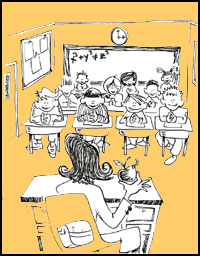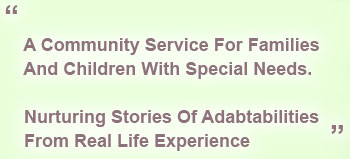Babyhood presents exquisitely the natural force in humans to grow, to strive, and to change. Parents delight in seeing their child take small steps through developmental milestones, and are filled with the hope that their child will develop into a happy, capable, and caring adult.
As a parent, what strengths and capacities
do you want your child to claim as an adult?
For various reasons, some parents, perhaps in determination to insure their child the best education, choose to home-school. Martin Seligman wrote in Authentic Happiness, that he and his wife are home-schoolers because they are both dedicated teachers by profession, enjoy ta iloring their children’s education around each child’s “signature strengths” and the family’s frequent travels. Although the Seligmans home school their children, they are not home-school “proselytizers”. (Authentic Happiness, page 246). Home schooling takes much time, energy and coordination.
iloring their children’s education around each child’s “signature strengths” and the family’s frequent travels. Although the Seligmans home school their children, they are not home-school “proselytizers”. (Authentic Happiness, page 246). Home schooling takes much time, energy and coordination.
Most parents do not have the resources that Dr. Seligman and his wife have and so put their trust in public or private school, as they want the structured setting with classmates and a trained teacher for their child. Nevertheless, as our society becomes more complex, sometimes threatening and even violent, some parents have misgivings about their child entering the big world of school. The child may pick up these concerns and consequently show much anxiety about going to school outside the home.
Why should my child leave the comfort and security of
home to venture out into an uncertain world of school?
| [Back to Top] |
In seeking further child enrichment outside of the family, some parents opt for a preschool experience. A preschool experience helps parent and child work on the natural anxiety of separation. The child’s transition between mother and preschool teacher is planned in small increments. A carefully planned, practiced, and more-comforting path to schooling outside the home for the kindergartner is then established. . Janet Brown McCracken has written an excellent article on how to handle the little goodbyes that ease the transition between home and groups for children and help prepare them for ultimate separations (1990,1997 by National Association for the Education of Young Children, www.naeyc.org/store/node/200 order #213).
A school experience outside the home provides for developmental opportunities that parents may not have time to provide. Daily interactions with teacher and peers in a trusting and learning environment help build upon an already-established family foundation. Family habits, rituals and culture are expanded to include a diversity of school schedules, routines and celebrations.
A good school program can add to the child’s world. Following are some potential positive and health-promoting factors, which can impact the child’s development:
- Child’s growth and integrity of development—sensory experiences promoting industry and competence in academic skill building (Piaget and Erickson).
- After child-teacher attachment is established, the child and teacher begin the reciprocity of interaction. Mutual wants and desires are negotiated and satisfied.
- Health promotion —vision, hearing and immunization checks are made.
- Learning emotional coping and modulation—modeling from peers (Bendor).
- The child may have the good fortune to experience and see a healthy partnership between parent and teacher for his or her own well-being.
- The child sees how adults of different backgrounds and cultures work together for a positive goal.
- Cognitive and emotional striving to higher expectation (psychodynamic view of regression? or sharing in the caretaker’s comfort)
- The child gains mastery over transitions between home and school.
- The child’s learning of transition anxiety measurement may be helpful when an emergency occurs in a family, or community, such as parent illness, parent need for time out of the home due to employment, or natural disaster.
- The child learns friendship skills and experiences cultural diversity.
- The child develops recreational skills and interest expansion.
- The child is exposed to a teaching gray area where there is less dichotomous learning, and more multi-perspective learning, cultural differences and richness. He or she receives broader experience and a sense of the real world not so much of the TV world.
- The child is taught social mores.
- The child becomes part of a school culture generational culture.
- The child has a wider base of caring adults in his or her world.
The National Association for Education of young children provides suggestion for helping the child start school, www.naeyc.org/store/node/190
| [Back to Top] |
If a parent, on the other hand, is pursuing home schooling, a structured plan is needed and local and national groups provide direction and support. Contact the Home School Specialist in your school district.
Web Sites
Additional websites that discuss ways to help your child and family get prepared for starting public or private school:
http://www.med.umich.edu/1libr/yourchild/bts.htm
http://www.naeyc.org/
Further Reading
Balaban, N. 1985 Starting school: From separation to independence (A guide for early childhood teachers). New York: Teachers College Press.
Dittman L.L. 1993, 2000. Finding the best care for your infant or toddler, Brochure. Washington, DC: NAEYC. Order #518.
Honig, A.S. 2002. Secure relationships: Nurturing infant-toddler attachment in early care settings. Washington, DC: NAEYC. Order
123.
Jervis, K.Ed. 1984. Separation: Strategies for helping two-to-four-year-olds. Washington. DC: NAEYC. Order #230.
Warren, R. 1977. Caring: Supporting children’s growth. Washington, DC: NAEYC. Order @213.
| [Back to Top] |








Social Networks
Follow Us